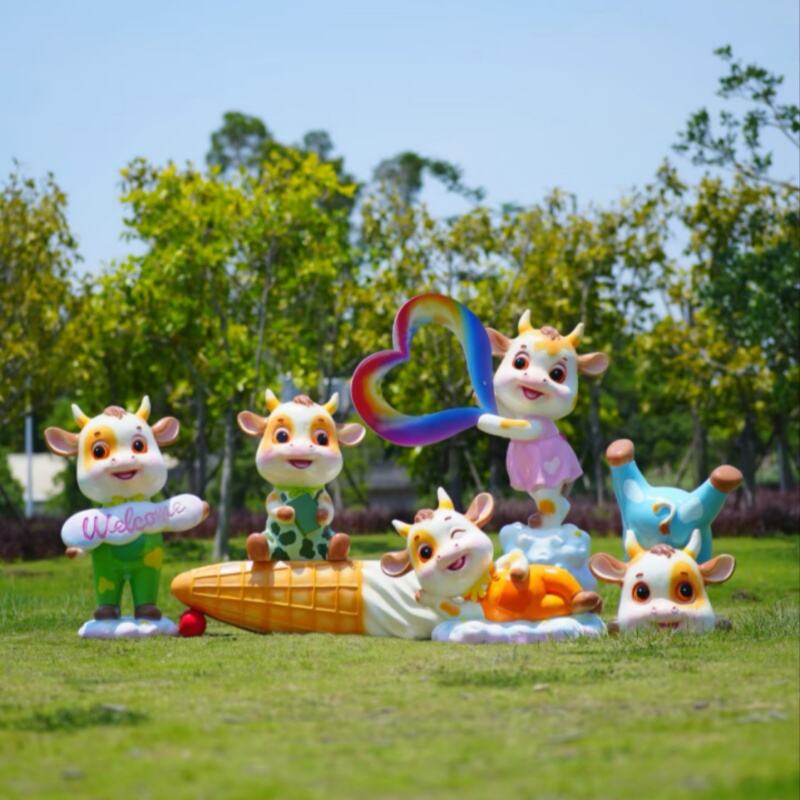The Evolution of Sculptures in Public Parks
From Classical Monuments to Modern Interactive Art
Monuments in the classical style have been central to public parks as historic memorials and cultural symbols. These statues and monuments have served as reminders of historic occurrences, local lore, or national patriotism, and as such, have invited contemplation and admiration from those who visit the park. But the art scenes at these parks have finally moved beyond traditional media to embrace modern, interactive art, creating a new and immersive experience for the public.
Transitioning to contemporary interactive art is a turning point in the way sculptures interact with people. By inviting interaction, and with the use of contemporary design, the installations are designed to get visitors involved and passers-by participating, demanding more attention and more action. For instance, virtuoso installations such as Anish Kapoor’s ‘Cloud Gate’ in Chicago indicate that this is a trend that brings positive results; with its highly reflective surface that positively encourages interaction and has captured the Social Media zeitgeist, drawing millions of visitors a year.
Examples of notable transitions include New York's High Line, where sculptures evolve from traditional forms to dynamic pieces that encourage interaction. According to statistics, such installations have increased park footfall significantly, demonstrating the appeal of modern interactive art in increasing park engagement.
Role of Public Art in Shaping Park Identities
Public art, and in particular sculpture, drives the strong sense of community identity and pride in place that public parks offer to their residents. Statues and monuments can represent local culture and history, while also adding beauty and points of interest in these green areas. Art installations can turn a park into a cultural destination that residents feel a sense of pride about and connection to.
The presence of public art not only enhances the visitor experience but also attracts tourists. Successful examples such as New York's Central Park and Seattle's Olympic Sculpture Park showcase how art installations boost tourism. These parks thus offer an enriched experience, drawing art enthusiasts and casual tourists alike.
Moreover, public art in parks has a notable psychological impact on community well-being. It creates environments that encourage relaxation and contemplation, contributing to mental health benefits as supported by research showing the positive effects of artistic expressions in green spaces.
Case Study: Iconic Sculptures Reshaping Urban Green Spaces
Iconic sculptures in urban parks throughout the world are transforming landscapes and community gathering places. Consider Millenium Park in Chicago and the “Crown Fountain,” an instantly-iconic space that has redefined public space visually and socially. And, such installations frequently experience significantly heightened traffic, emphasizing the inherent appeal of public art.
Local governments, as well as artists alike, often tout the beneficial effects of the installation on city life. Once industrial or unimproved areas have transformed into vibrant cultural locales, like Philadelphia’s LOVE Park. The participation and support of artists and the community have created works that resonate with the public, attracting tourists and adding value to the lives of residents.
The community responses to these sculptures have generally been positive, with noticeable changes in local demographics and tourism flows. These projects not only beautify urban spaces but also serve as catalysts for community engagement and economic development, proving the transformative power of iconic sculptures in urban green spaces.
Enhancing Aesthetic and Cultural Value with Sculptures
Integrating Artistry with Park Landscapes
Art and nature combined in a park setting can turn an ugly area into a pretty one. Artists frequently apply methods such as following lines and shapes in the landscape to facilitate the sculptures blend in with their environment. The Bentway Staging Grounds here in Toronto is a good example of something that combines Picnics themes in the form of a portion of a public park and by being located underneath the Gardiner Expressway. In so doing it puts art and education in an unused space with improvements to aesthetics and nature interaction. Landscape artistry pros say the secret is expertly blending sculpture design with the environment, so they work in concert rather than at odds.
Cultural Narratives Through Environment-Themed Sculptures
Sculptures on topics of environment offer the unique opportunity to narrate cultural stories and articulate society's sentiments about nature and conservation. Public art programs also allow communities to shape these stories, with sculptures that communicate community values and issues. For instance a project like the Storkeengen in Vorup illustrates how sculptures can encapsulate themes of climate resilience as well as turning natural sites into symbols of ecological adaptation. Interviews with townies are often a sense of increased consciousness of environmental problems through the provocation of the works, thereby stretching our photographic exhibitionary reach.
Sculptures as Tools for Social Awareness
Sculpture is a strong medium for the direct approach of social issues, acting as a catalyst for conversation and stimulating the awareness of a community. Monumental sculptural installations like Philadelphia’s refurbished Dilworth Park fountains act as catalysts for social interaction, encouraging conversation and action by the general public. This kind of art project is often able to document its effects via increases in community participation and local advocacy. Entire statistics are sometimes devoted to the enhanced foot traffic and the social traffic that these sculptures provoke, demonstrating that art does more than just standard-issue color in a community, it pulls a community together.
Local Artists and Authentic Public Installations
Amplifying Community Voices Through Art
Local artists are instrumental in helping to elevate the voice of the local communities through public installation sounds projects. Through collaboration with local residents the artists construct artworks which communicate history and shared stories. For example, community projects emphasizing murals and sculptures often succeed because they highlight local artists and create a sense of ownership and pride among residents. People who have been involved are commonly testimony to the increased sense of community identity and well-being that results, and it is clear that art is not merely something which is decorative and which makes spaces look good: art has the power to shape social relationships.
Collaborative Projects Between Cities and Artists
Partnerships between local governments and artists result in inventive public art installations that beautify the cityscape. These collaborations spawn joint planning and execution processes and lead to many high-profile projects that have a tremendous influence on public engagement, visits and tours. Cities that have entered partnerships like these have reported higher foot traffic and greater community participation, for instance. Emerging abilities tend to result in ongoing benefits for the project and community, professional perspectives have found that sustainable practices frequently arise from these interventions.
Case Study: Grassroots Sculpture Initiatives
Art in the community can revitalize neighborhoods and energize public space. Dorling’s examples of such movements are, in case study terms, invested with an extraordinary power to mobilize communities around the shared goal of artistic endeavour and public amelioration. By charting their progress from concept to reality, we can trace the power of such projects to change the way local people are engaging with the arts. Measure of Success Measures of success, such as more visitors and greater respect from the public for local culture, highlight the ripple effects of grassroots efforts. These projects are not only enhancing culture, but enhancing location and ownership in the community.
Sustainability in Sculpture Design and Materials
Eco-Friendly Materials for Durable Art
Sustainable materials are more and more a factor in sculptural design, with an emphasis on strength and sustainability. Artists are using more materials like stainless steel, with its weather resistance and recyclability, that will contribute to the longevity of the sculptures while having the least impact on the environment. For example, sculptures made from recycled plastics and bamboo demonstrate that innovative substitutes can drive sustainable options, extending overall life while minimizing negative impact on the environment. Sustainable sourcing not only respects the nature we live in, but adds to the art community by promoting creativity through form and materials.
Sculptures Promoting Environmental Stewardship
Sculpture as a tool for environmental advocacy Can sculptures be potent advocates for the environment? Using visual narratives like sculpture can help to capture the public’s attention and understanding. Installations like Olafur Eliasson’s “Ice Watch” showcase melting blocks of ice in urban centers and serve as some of the most poignant symbols of an environmental crisis. These Art Works have deep resonance within the communities and can proved excellent levels of sensitization on conservation issues. Quoting Héctor Tió, a noted authority on environmental art, “[^art] can capture our imaginations and foster discussions on what would make our communities more sustainable,” he noted, highlighting the sculptures’ function as advocates of environmental policy.

Solar-Powered and Recyclable Art Innovations
Advances in sculpture range from adding solar operated elements to practicing “green sculpting” which merge the beauty of art with environmental ethic. Initiatives such as the “Solar Flame” demonstrate the incorporation of solar panels into metal sculptures that cause art work to glow at night with no power. And, artists such as myself are focusing on using reusable materials to create pieces that are not only gorgeous, but are eco-friendly. These works celebrate the crossroads of creative and sustainable living, showcasing environmentally-friendly design.
Sculptures as Tools for Social Awareness
Creating Iconic Park Features Through Art
All these urban parks have also become important containers of scultures as featured objects of identification and branding. Central to this is the creation of landmark art installations that enthrall the public and define the cities in which they are located. In Chicago's Millennium Park, "The Bean" or "Cloud Gate" is one of the most photographed sculptures in U.S. attracting millions of tourists annually. These are the types of draws which not only contribute substantially to local tourism, but which are also critical – as demonstrated by Millennium Park’s 2019 tally of over 20 million visitors – to the cultural infrastructure of a city.
Economic Impact of Landmark Sculptures
Sculptures bring with them significant financial benefits to the tourism and commerce industries. These monuments-straightjacketed for decades-are not only totems of our culture, but economic generators in action. One fine example is New York City’s Statue of Liberty; it brings in people from all over the world who spend money locally. Tourist destinations such as the Statue of Liberty are a major boon to the city economy, helping to sustain a variety of jobs and businesses, from infantilizing theme hotels to frankly disgusting restaurants to dinky little shops.
Balancing Aesthetics with Functional Design
Aesthetics and utility In editspeak How Robusta Escultura literally dreams beauty and functionality Esthetics - aesthetic or functional aesthetics - have a strong part as regards esthetic and functional design in the sculptures dream and deliver. They should be spaces, not just something to look at. Consider the “Crown Fountain,” in Chicago, for example, which is a piece of public art that doubles as a skateable sculpture. Such a balance increases attention to and use of the works, making sculptures an integrated, vibrant part of urban park use.
FAQ Section
Why are modern interactive arts becoming popular in public parks?
Modern interactive arts are becoming popular as they engage visitors in a participatory way, making public art more accessible and immersive.
How do sculptures enhance the identity of public parks?
Sculptures in public parks serve as tangible expressions of local culture and history, enhancing aesthetic appeal and creating memorable landmarks, which foster community pride and connection.
What is an example of a successful public park sculpture installation?
An example is "Cloud Gate" in Chicago's Millennium Park. Its interactive design has made it a major attraction, drawing millions of tourists annually.
What role do artists play in community public art projects?
Local artists engage residents in the creative process, constructing artwork that reflects cultural heritage and shared narratives, which enhances community identity and cohesion.
How do sculptures contribute to sustainability?
Sculptures promote sustainability by using eco-friendly materials like stainless steel or recyclable parts, advocating for environmental stewardship through visual storytelling.
Table of Contents
- The Evolution of Sculptures in Public Parks
- Enhancing Aesthetic and Cultural Value with Sculptures
- Local Artists and Authentic Public Installations
- Sustainability in Sculpture Design and Materials
- Sculptures as Tools for Social Awareness
-
FAQ Section
- Why are modern interactive arts becoming popular in public parks?
- How do sculptures enhance the identity of public parks?
- What is an example of a successful public park sculpture installation?
- What role do artists play in community public art projects?
- How do sculptures contribute to sustainability?


